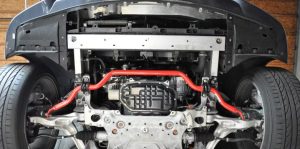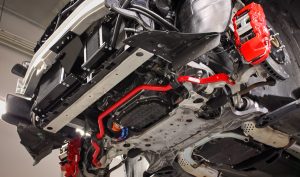When it comes to improving vehicle handling, stability, and overall driving dynamics, the stabilizer bar — also known as a sway bar or anti-roll bar — plays a crucial role. Often overlooked compared to shocks or springs, this simple yet vital suspension component is responsible for reducing body roll during cornering, keeping the vehicle more level and predictable on the road. However, two key factors — thickness and material composition — significantly influence how a stabilizer bar performs.
Whether you’re building a performance car, enhancing handling for daily driving, or upgrading for heavy-duty use, understanding how these factors affect suspension behavior can help you make informed decisions.
The Basics: What Does a Stabilizer Bar Do?

A stabilizer bar connects the left and right sides of a vehicle’s suspension, twisting slightly as the car leans into a turn. This resistance to torsion reduces body roll and improves tire contact with the road, resulting in:
-
Better cornering stability
-
Enhanced steering response
-
Improved ride comfort and safety
-
More balanced weight transfer
The effectiveness of this roll control depends largely on the stiffness of the bar, which is determined by both its diameter (thickness) and the material it’s made of.
The Impact of Stabilizer Bar Thickness
The diameter of the stabilizer bar directly influences its stiffness — and even small changes can make a significant difference. In fact, stiffness increases roughly with the fourth power of the diameter, meaning a minor increase in thickness can result in a major jump in roll resistance.
| Bar Diameter | Relative Stiffness | Typical Use Case |
|---|---|---|
| 18 mm | 1x (baseline) | Standard OEM setup for comfort |
| 20 mm | ~1.5x | Slightly firmer handling, minimal comfort loss |
| 22 mm | ~2.4x | Sport-tuned suspension for improved cornering |
| 25 mm+ | ~4.8x or higher | Performance or track-oriented setups |
Key Takeaways:
-
Thicker bars = higher roll stiffness: This reduces body roll and sharpens cornering.
-
Too stiff = reduced comfort: Excessive stiffness can make the ride harsh, especially on rough roads.
-
Balanced approach is best: Choose a bar that complements your springs, shocks, and driving style.
How Material Choice Affects Performance
While thickness determines the mechanical stiffness of a sway bar, the material influences its strength, weight, flexibility, and durability. Each material type has distinct properties and trade-offs.
| Material Type | Strength & Stiffness | Weight | Durability | Cost | Best For |
|---|---|---|---|---|---|
| Standard Steel | High | Heavy | Excellent | Low | OEM, daily driving |
| Chromoly Steel | Very High | Moderate | Very Good | Medium | Performance & racing |
| Aluminum | Moderate | Light | Good | High | Lightweight builds, EVs |
| Composite (Carbon Fiber) | Exceptional | Very Light | Excellent | Very High | High-end performance, racing |
Material Insights:
-
Standard steel: Most common due to affordability and strength but adds weight.
-
Chromoly steel (alloy): Offers increased stiffness without excessive weight — ideal for performance upgrades.
-
Aluminum: Reduces weight but may sacrifice some stiffness; good for weight-sensitive builds.
-
Carbon fiber: Premium choice with exceptional strength-to-weight ratio but extremely expensive.
Finding the Right Balance: Thickness vs. Material
The ideal stabilizer bar for your vehicle depends on your driving style, vehicle type, and performance goals. Consider these guidelines:
For Daily Driving:
-
Thickness: Slightly larger than stock (e.g., +2–4 mm)
-
Material: Standard or chromoly steel
-
Goal: Improved handling without sacrificing ride comfort.
For Performance / Track Use:
-
Thickness: Significantly larger (+4–8 mm or more)
-
Material: Chromoly or composite
-
Goal: Maximum roll resistance, sharper cornering, and improved weight transfer.
For Towing / Heavy-Duty Use:
-
Thickness: Substantially larger (+6 mm or more)
-
Material: Heavy-duty steel
-
Goal: Improved stability under load and reduced sway.
Pros and Cons of Upgrading Stabilizer Bars
| Pros | Cons |
|---|---|
| Improved cornering and handling | Potentially harsher ride |
| Reduced body roll and lean | May increase understeer or oversteer if not balanced |
| Better weight distribution during turns | Incorrect size/material can upset suspension geometry |
| Enhanced traction and tire grip | Higher cost for performance materials |
Tips for Choosing the Right Stabilizer Bar

Before purchasing or upgrading your sway bar, keep these tips in mind:
-
Match it to your suspension setup – Pair with compatible springs and dampers.
-
Consider weight distribution – Heavier vehicles may need thicker or stronger bars.
-
Upgrade bushings and links – New bars often require stronger end links or polyurethane bushings.
-
Avoid extremes – Oversizing the bar can reduce suspension compliance and grip.
-
Consult a professional – If unsure, get advice based on your driving needs and vehicle specs.
Conclusion
The stabilizer bar may seem like a simple metal rod, but its thickness and material dramatically affect how a vehicle behaves on the road. A well-chosen sway bar enhances handling, cornering, comfort, and safety — while a mismatched one can negatively impact ride quality and suspension balance.
Whether you’re fine-tuning a performance car, improving everyday drivability, or strengthening a heavy-duty vehicle, selecting the right stabilizer bar is key. By understanding how diameter and material work together, you can make an upgrade that transforms the way your car feels and performs.
And when you’re ready to make that upgrade, you can easily find high-quality options and order your Stabilizer & Components online to match your exact needs and specifications.